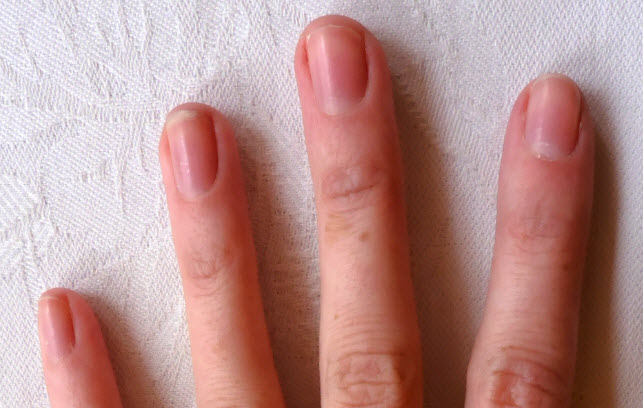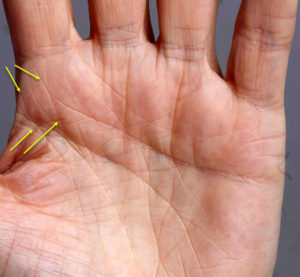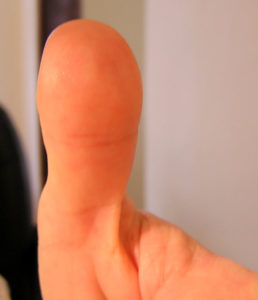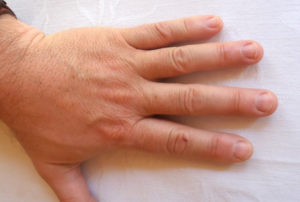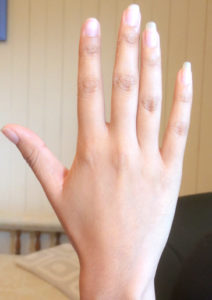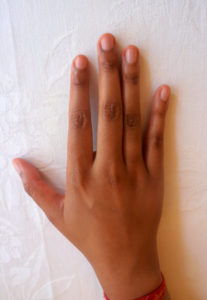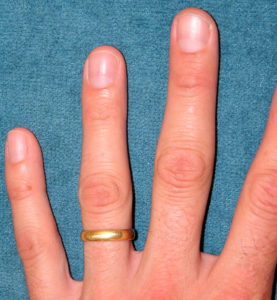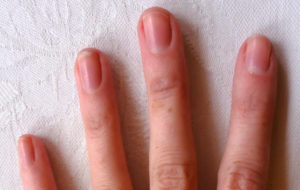Welcome to my palm images page. This offers a range of photos of hands, fingers, thumbs and lines to illustrate the ancient study of palmistry. I’ll add to this page from time to time as I see unusual hands. All images on this page are copyright protected. (c) Copyright 2017 Paul Fenton-Smith.
Square on Jupiter.
This is a ‘Teacher’s Square’ and it shows a natural talent for teaching others. It indicates the tendency to teach through simplification and with a ‘hands-on’ approach to learning by encouraging participation, as opposed to rote learning.
Clubbed Thumbs.
These thumbs are short but the will (first) phalange is swollen or very full and protruding, increasing determination and persistence. People with clubbed thumbs usually have a very long fuse. They rarely lose their tempers but when they do, anger quickly turns to rage and fury. They can clear a room instantly as people around them rush to safety.
When pushed beyond endurance they become fearless, lashing out with scant regard for the consequences. Most people with these thumbs tend to know when they are about to snap and they’ll leave the room, removing themselves from the environment. At this point they are usually shaking, while adrenaline surges through the bloodstream. They instinctively know what they are capable of and walk away before they lash out. Traditional palmists called this type of thumb ‘the murderer’s thumb’. It was named because crimes of passion were sometimes committed by people with these thumbs.
Spatulate hands.
With spatulate hands, the fingertips often resemble a chemist’s spatula. This is usually a wide hand, that is quite firm, with almost triangular nails. The nails are always wider at the tip than at the base. There is normally plenty of space between the fingers, even when relaxed on the table, palm downwards.
People with spatulate hands are usually sceptical, scientific and analytical. These people generally love freedom, space, travel, change, independence, challenge, competition and they want to know how things work. They sometimes like to take objects apart simply to see what makes them tick.
They are usually inventive in practical ways. Individuals with spatulate hands are usually particularly enthusiastic about trying out their ideas, which tend to be either brilliant or disastrous. These people require proof because they are naturally sceptical by nature.
Psychic hands
Psychic-handed people are generally idealistic. They appreciate the inner beauty of everything, seeking not to disturb the equilibrium but rather to observe the flow of life towards its real purpose. They perceive life as a magical, spiritual experience and despair of people who believe that life is simply about materialistic gains.
These people are gentle, kind and caring to those who need help and, as such, are often taken for granted or abused by individuals who relate a sad story to enlist their pity. They trust anyone who is kind to them and are usually unsuited to business, being essentially impractical. They can be easily deceived due to their trusting natures. They deeply resent this duplicity and repeated disappointment finds them withdrawing into themselves and pursuing their goals only through imagination. Instead of actively setting and achieving personal objectives, they dream of success without making any substantial effort. This is not to suggest they are foolish or unintelligent, simply that from their perspective, incidental issues and circumstances sometimes have as much meaning as momentous achievements.
People with psychic hands are in this world but not of this world. They know that, in the end, none of what we gather can be taken with us and that desires and accumulated possessions only hold us back. Theirs is a life of detachment. Consciously or not, they are religious by nature, attracted to magic and mystery. They are often naturally intuitive and need to avoid much of life’s negativity. They usually make good mediums, clairvoyants and psychic readers, although this drains their limited energy supplies.
Large moons in the nails.
Large moons (up to one third of the nails) denote good blood circulation. Southern European and Middle Eastern people often have large moons. Their enthusiastic approach to life is usually assisted by healthy blood circulation. Regular exercise improves the blood circulation and consequently, the size of the moons.
Narrow, bowed nails.
Long narrow fingernails that bow (When examined from the tips of the fingers they curve like an archer’s bow) indicate issues with the chest and lungs. With a prominent Luna mount the person is likely to experience more chest colds and with a full Mount of Mercury there is a susceptibility to asthma or bronchial issues.
Long Fingers.
People with long fingers generally have a more intellectual approach to life. The need to understand the why, what, when where and who of life. Shorter fingers suggest a more instinctive nature – someone who can make effective decisions by what feel right at the time.
The Girdle of Venus.
A Girdle of Venus is often found in the hands of individuals up to 30 years of age but rarely appears in people aged over 60. The Girdle of Venus indicates a lack of commitment, perhaps explaining why long term commitment to goals particularly relationship aims, is less evident in younger people.
When a Girdle of Venus is located in a hand, look for a line running through the Life line to the Saturn mount. This line is called a Line of Influence. Where the Line of Influence cuts the Life line it corresponds to a time in the person’s life when he or she made a very important emotional decision about life. It signifies a period when this individual decided that people were not to be trusted.
It might be related to a broken relationship between the parents; physical, emotional, mental or sexual abuse from the parents or guardians or simply a severe lack of emotional support and commitment from the parents. This decision generally leads to a lack of commitment to self, loved ones and personal plans for the future. These people sometimes remain as children, developing physically and intellectually but remaining emotionally stuck at the age when the decision was made.
